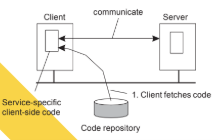code migaration
1/18
There's no tags or description
Looks like no tags are added yet.
Name | Mastery | Learn | Test | Matching | Spaced |
|---|
No study sessions yet.
19 Terms
code migration
process of moving executable code from one machine to another in a distributed system to improve performance, efficiency, or flexibility; avoids pre-installing software and increases dynamic configuration.

load distribution
ensuring that servers in a data center are sufficiently _ (e.g., to prevent waste of energy); minimizing communication by ensuring that computations are close to where the data is (think of mobile computing).
flexibility
moving code to a client when needed
client-server
the client sends a request to a server. The server processes the request locally and sends back the result; code stays put, only data moves between client and server.

remote evaluation
the client sends code to the server to be executed there; useful when the server has more data or resources.; code moves from client to server.

code on demand
the server sends code to the client, where it's executed, often used when clients need dynamic behavior or updates; code moves from server to client.

mobile agents
(code + execution state + data) moves from host to host, executing parts of its task at each; code and state move between systems.

code segment
contains the actual code
data segment
contains the state
execution state
contains the context of the thread executing the object’s code
weak mobility
move only code and data segment (and reboot execution)
code shipping
push
code fetching
pull
strong mobility
move component, including execution state
migration
move the entire object from one machine to the other
cloning
start a _, and set it in the same execution state.
pre-copy strategy
low downtime, high performance, medium complexity, widely used in practice
stop-and-copy strategy
high downtime, low complexity, simple but disruptive
post-copy strategy
low downtime; variable performance, high complexity, fast start but riskier